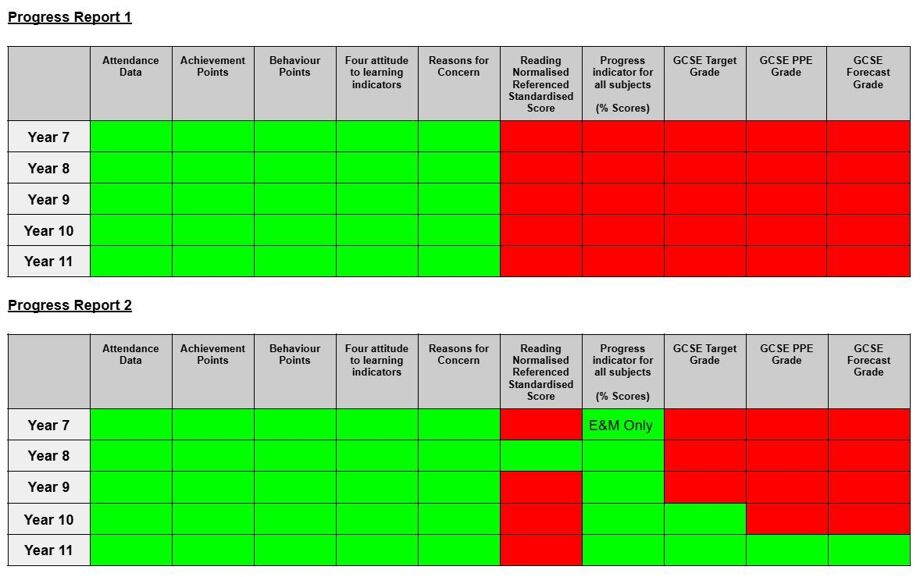Assessment & Reporting
Reporting and assessment at Glyn has two threads:
- Regular low stakes assessment/testing/checking with feedback that takes place in every lesson.
- Cumulative summative assessment: at certain points during the school year, students take summative assessments to assess the students’ learning over the course of a term or year. The assessment will cover a sample of questions from everything the students have been taught. These tests provide us with data to help to identify patterns of performance.
Key Stage 3
How we will Report to Key Stage 3 Families
In Year 7, 8 and 9, families will receive the following Progress Reports (PR):
PR 1, 2 and 3 will all contain:
- Attendance
- Achievements Points
- Behaviour Points
- Three ‘Attitude to Learning’ (ATL) indicators
- Any details regarding a ‘Reasons for Concern’
For PR 2 and 3 only, in addition to the above, families will also receive Progress Data:
In Year 7
- Attendance
- Achievement Points
- Behaviour Points
- Three attitude to learning indicators
- Progress indicator for English and Maths (Term 2)
- Progress indicator for all subjects (Term 3 only)
- Reasons for Concern
In Year 8
- Attendance
- Achievement Points
- Behaviour Points
- Three attitude to learning indicators
- Progress indicator for all subjects
- Reasons for Concern
In Year 9
- Attendance
- Achievement Points
- Behaviour Points
- Latest Assessment score per subject
- Assessment Average and Highest % scores for the cohort
- Three attitude to learning indicators
- Causes for concern if applicable
Progress Indicators
On PR 2 and 3, in addition to the percentage data, families will see the following terms used to indicate progress:
‘Above Expected’
‘At Expected’
‘Below Expected’
When your son joined Glyn in Year 7, Key Stage 2 Scores were used to rank students according to English and Maths only. Their first round of assessments for other subjects will be used as a baseline for those subjects. After PR 3 when your son is/was in Year 7, students are re-ranked and potentially moved to a new percentile. If they move up a percentile this will be indicated as ‘above expected’, if they remain in the same percentile ‘at expected’, if they move down ‘below expected’.
In PR 2 and 3 in Years’ 8 and 9, this ranking is repeated, always using the previous assessment as the ‘new’ baseline and subsequent indication of percentile movement.
Why we organise Key Stage 3 reports in this way
- KS2 outcomes inform a GCSE target grade, however we do not believe that it is appropriate to assign a GCSE grade to assessed work during KS3. GCSE exams assess the full breadth of the taught curriculum whereas the KS3 assessment intent is to assess their core knowledge and the conceptual understanding of specific disciplines needed to build subject scholarship.
- The students are not judged against GCSE criteria at this point, a ranking system is more appropriate as a starting point.
- Reports will then indicate if progress has or has not been made between PR2 and PR3 in a way that is fairer and more reflective of their actual progress.
Key Stage 4
How we will Report to Year 10 Families
PR1 is ATL only. PR 2 and 3 is identical to KS3 and Year 9, however for Year 10 we will now include the GCSE target grade on the report.
Families should note we do not use, award or refer to GCSE Grades during Year 10. To this end there will be no GCSE grading shared on either assessed work, or Progress Reports.
Why do we not use GCSE Grades in Year 10?
- Providing GCSE grades to Year 10 for pieces of work is potentially misleading and inaccurate: full courses have not been covered.
- Even ‘subject-created’ mark schemes include a degree of subjectivity and speculation that can potentially provide false insight to students and families
- Making formal GCSE grading/judgements after the completion of only part each subject’s curriculum, is something we as a a teaching body, do not attach any compelling validity to: such forecasts in Year 10 will likely change significantly in Year 11 once more of the curriculum has been completed: therefore treating them as ‘predictions’ or ‘performance indicators’ is not something that we include as part of our assessment process for Year 10
How we will Report to Year 11 Families
PR1 is ATL only.
PR2 and 3 will include a PPE 1 & 2 outcome/garde respectively - teachers will also provide a ‘Forecast Grade’ on PR2. The Forecast Grade is based on the knowledge the subject teacher has of the student after PPE1. This is the grade the subject teacher projects the student to achieve if all of the their ATLs are good/excellent, combined with high attendance and excellent punctuality; this grade will be shared on reports. Percentage scores will also be presented.


Key Stage 5
How we will Report to Sixth Form Families
Year 12 students will receive four reports throughout the year. The first report does not include grades.
Reports include:
- Attendance
- Target Grade; separate reports for BTEC subjects are also sent for Years 12 and 13 as the layout is different from the main report due to how the subject is assessed.
- Latest Assessment score per subject
- Assessment Average and Highest % scores for the cohort
- Attainment, if applicable
- PPE grades, if applicable
- Four attitudes to learning indicators
Year 13 students will receive three reports throughout the year.
Reports include:
- Attendance
- Target Grade
- Attainment
- Assessment Average and Highest % scores for the cohort
- PPE grades, if applicable
- Four attitudes to learning indicators
A separate report containing the UCAS predicted grades will also be received at the start of Term 1.



